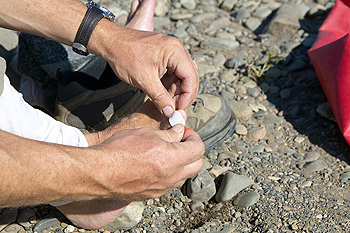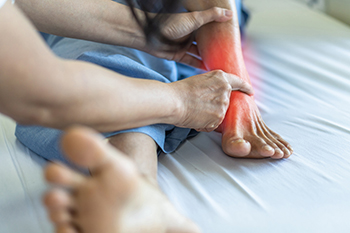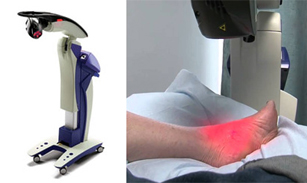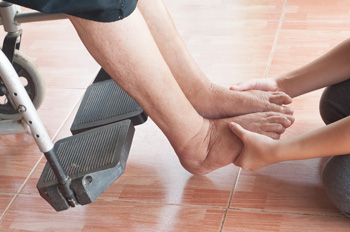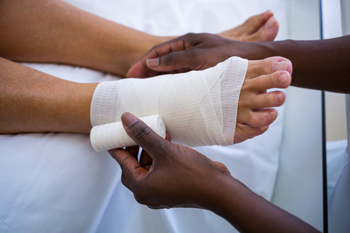Blog
Where Heel Pain Can Come From
 Heel pain can be debilitating and have a brutal impact on everyday life. While there are a variety of causes of heel pain, the most common is plantar fasciitis. This happens when there is inflammation or even a partial tear in the tissue running along the bottom of the foot that connects the heel to the toes, known as the plantar fascia. Heel pain can also occur when there is an abnormal growth on the heel bone that is a result of a calcium buildup. This is known as a heel spur. Other common sources of heel pain include Calcaneal apophysitis (irritation of the heel bone from new shoes or a new activity), bursitis (inflammation of the sac that lines some joints), or when a nerve gets compressed (also known as a trapped nerve). If you are struggling with heel pain, consulting with a podiatrist is a good idea. A podiatrist will be able to find the cause of the heel pain and suggest the treatment options that are available.
Heel pain can be debilitating and have a brutal impact on everyday life. While there are a variety of causes of heel pain, the most common is plantar fasciitis. This happens when there is inflammation or even a partial tear in the tissue running along the bottom of the foot that connects the heel to the toes, known as the plantar fascia. Heel pain can also occur when there is an abnormal growth on the heel bone that is a result of a calcium buildup. This is known as a heel spur. Other common sources of heel pain include Calcaneal apophysitis (irritation of the heel bone from new shoes or a new activity), bursitis (inflammation of the sac that lines some joints), or when a nerve gets compressed (also known as a trapped nerve). If you are struggling with heel pain, consulting with a podiatrist is a good idea. A podiatrist will be able to find the cause of the heel pain and suggest the treatment options that are available.
Many people suffer from bouts of heel pain. For more information, contact Elliot T. Udell, DPM of New York. Our doctor can provide the care you need to keep you pain-free and on your feet.
Causes of Heel Pain
Heel pain is often associated with plantar fasciitis. The plantar fascia is a band of tissues that extends along the bottom of the foot. A rip or tear in this ligament can cause inflammation of the tissue.
Achilles tendonitis is another cause of heel pain. Inflammation of the Achilles tendon will cause pain from fractures and muscle tearing. Lack of flexibility is also another symptom.
Heel spurs are another cause of pain. When the tissues of the plantar fascia undergo a great deal of stress, it can lead to ligament separation from the heel bone, causing heel spurs.
Why Might Heel Pain Occur?
- Wearing ill-fitting shoes
- Wearing non-supportive shoes
- Weight change
- Excessive running
Treatments
Heel pain should be treated as soon as possible for immediate results. Keeping your feet in a stress-free environment will help. If you suffer from Achilles tendonitis or plantar fasciitis, applying ice will reduce the swelling. Stretching before an exercise like running will help the muscles. Using all these tips will help make heel pain a condition of the past.
If you have any questions please contact our office located in Hicksville, NY . We offer the newest diagnostic and treatment technologies for all your foot and ankle needs.
Potential Achilles Tendon Injuries
 If you feel the back of your ankle, you will notice the fibrous tissue that connects the heel bone to the calf muscle. This is known as the Achilles tendon. There are two injuries that commonly affect this tendon. The first, known as Achilles tendinopathy, occurs when there is pain on the back of the heel as a result of overuse. Common signs of Achilles tendinopathy include swelling, stiffness, and pain that is worse in the morning. The second injury is an Achilles tendon rupture or tear, which commonly occurs as a result of jumping and pivoting with a lot of force. This causes the tendon to overstretch and eventually tear. Anyone who tears their Achilles tendon will notice a severe pain and a loss of both movement and strength in the tendon. If you are experiencing pain or swelling in your Achilles tendon, it is suggested that you consult with a podiatrist who can help provide a treatment option for injuries as well as ways to prevent a rupture.
If you feel the back of your ankle, you will notice the fibrous tissue that connects the heel bone to the calf muscle. This is known as the Achilles tendon. There are two injuries that commonly affect this tendon. The first, known as Achilles tendinopathy, occurs when there is pain on the back of the heel as a result of overuse. Common signs of Achilles tendinopathy include swelling, stiffness, and pain that is worse in the morning. The second injury is an Achilles tendon rupture or tear, which commonly occurs as a result of jumping and pivoting with a lot of force. This causes the tendon to overstretch and eventually tear. Anyone who tears their Achilles tendon will notice a severe pain and a loss of both movement and strength in the tendon. If you are experiencing pain or swelling in your Achilles tendon, it is suggested that you consult with a podiatrist who can help provide a treatment option for injuries as well as ways to prevent a rupture.
Achilles tendon injuries need immediate attention to avoid future complications. If you have any concerns, contact Elliot T. Udell, DPM of New York. Our doctor can provide the care you need to keep you pain-free and on your feet.
What Is the Achilles Tendon?
The Achilles tendon is a tendon that connects the lower leg muscles and calf to the heel of the foot. It is the strongest tendon in the human body and is essential for making movement possible. Because this tendon is such an integral part of the body, any injuries to it can create immense difficulties and should immediately be presented to a doctor.
What Are the Symptoms of an Achilles Tendon Injury?
There are various types of injuries that can affect the Achilles tendon. The two most common injuries are Achilles tendinitis and ruptures of the tendon.
Achilles Tendinitis Symptoms
- Inflammation
- Dull to severe pain
- Increased blood flow to the tendon
- Thickening of the tendon
Rupture Symptoms
- Extreme pain and swelling in the foot
- Total immobility
Treatment and Prevention
Achilles tendon injuries are diagnosed by a thorough physical evaluation, which can include an MRI. Treatment involves rest, physical therapy, and in some cases, surgery. However, various preventative measures can be taken to avoid these injuries, such as:
- Thorough stretching of the tendon before and after exercise
- Strengthening exercises like calf raises, squats, leg curls, leg extensions, leg raises, lunges, and leg presses
If you have any questions please feel free to contact our office located in Hicksville, NY . We offer the newest diagnostic tools and technology to treat your foot and ankle needs.
What Is the Difference Between a Regular Blister and a Blood Blister?
Blisters are fluid-filled bubbles of raised skin that typically form on the feet due to excessive, repetitive friction over a concentrated area. The fluid inside blisters is most often clear and acts to protect the raw skin underneath the blister from further harm. However, some blisters are filled with blood, instead. This happens when a blood vessel is damaged and blood leaks into the skin. Unlike regular blisters, blood blisters are usually the result of a sudden impact or pinching of the skin, rather than friction. The skin underneath a blood blister may be more prone to infection, so it is very important that you avoid popping or otherwise irritating the blister. If you have particularly painful blisters on the feet, have blisters that appear to be infected, or get blisters very often, it is suggested that you seek the care of a podiatrist.
Blisters may appear as a single bubble or in a cluster. They can cause a lot of pain and may be filled with pus, blood, or watery serum. If your feet are hurting, contact Elliot T. Udell, DPM of New York. Our doctor can provide the care you need to keep you pain-free and on your feet.
Foot Blisters
Foot blisters are often the result of friction. This happens due to the constant rubbing from shoes, which can lead to pain.
What Are Foot Blisters?
A foot blister is a small fluid-filled pocket that forms on the upper-most layer of the skin. Blisters are filled with clear fluid and can lead to blood drainage or pus if the area becomes infected.
Symptoms
(Blister symptoms may vary depending on what is causing them)
- Bubble of skin filled with fluid
- Redness
- Moderate to severe pain
- Itching
Prevention & Treatment
In order to prevent blisters, you should be sure to wear comfortable shoes with socks that cushion your feet and absorb sweat. Breaking a blister open may increase your chances of developing an infection. However, if your blister breaks, you should wash the area with soap and water immediately and then apply a bandage to the affected area. If your blisters cause severe pain it is important that you call your podiatrist right away.
If you have any questions, please feel free to contact our office located in Hicksville, NY . We offer the newest diagnostic and treatment technologies for all your foot care needs.
It's Time for Beautiful Feet
When It Hurts to Bend Your Ankle
Ankle impingement occurs when either soft tissue or bone fragments get compressed, or trapped, if you bend your ankle. This impingement is usually a result of an acute injury, or prolonged stress from repetitive activities. Ankle impingement can either be anterior (affecting the front part of the ankle) or posterior (affecting the back part of the ankle). Anterior ankle impingement usually causes pain on the front/outside of the ankle when the ankle is bent upward (dorsiflexion). Posterior ankle impingement can produce pain in the back of the heel when the ankle is pointed downward (plantarflexion). Ankle impingement is often diagnosed in athletes who play soccer and football, as well as in dancers, gymnasts, and runners. If you have this type of ankle pain, a podiatrist can help you restore ankle stability with certain strengthening exercises, while treating pain and inflammation with rest, icing, anti-inflammatory medication, steroid injections, or even surgery in some cases.
Ankle pain can be caused by a number of problems and may be potentially serious. If you have ankle pain, consult with Elliot T. Udell, DPM from New York. Our doctor will assess your condition and provide you with quality foot and ankle treatment.
Ankle pain is any condition that causes pain in the ankle. Due to the fact that the ankle consists of tendons, muscles, bones, and ligaments, ankle pain can come from a number of different conditions.
Causes
The most common causes of ankle pain include:
- Types of arthritis (rheumatoid, osteoarthritis, and gout)
- Ankle sprains
- Broken ankles
- Achilles tendinitis
- Achilles tendon rupture
- Stress fractures
- Bursitis
- Tarsal tunnel syndrome
- Plantar fasciitis
Symptoms
Symptoms of ankle injury vary based upon the condition. Pain may include general pain and discomfort, swelling, aching, redness, bruising, burning or stabbing sensations, and/or loss of sensation.
Diagnosis
Due to the wide variety of potential causes of ankle pain, podiatrists will utilize a number of different methods to properly diagnose ankle pain. This can include asking for personal and family medical histories and of any recent injuries. Further diagnosis may include sensation tests, a physical examination, and potentially x-rays or other imaging tests.
Treatment
Just as the range of causes varies widely, so do treatments. Some more common treatments are rest, ice packs, keeping pressure off the foot, orthotics and braces, medication for inflammation and pain, and surgery.
If you have any questions, please feel free to contact our office located in Hicksville, NY . We offer the newest diagnostic and treatment technologies for all your foot care needs.
MLS Laser Therapy May Help Lessen Attacks of Raynaud’s Disease
Raynaud’s disease (also known as Raynaud's phenomenon) is a vascular condition where small blood vessels in the extremities constrict suddenly (vasospasm) in response to cold temperatures or stress. This can cause the toes to suddenly feel icy, numb or painful, and possibly even turn blue or white. As the spasms subside, a pins and needles sensation may be present and the affected area may turn red. Certain diseases, injuries or conditions may increase a person’s risk of developing Raynaud’s disease. Multiwave Locked System (MLS) laser therapy is a possible treatment option for some patients suffering from Raynaud’s disease. MLS laser therapy is an FDA cleared, non-invasive treatment modality that utilizes a combination of specific wavelengths to help repair damaged cells and accelerate the body’s natural healing mechanism. Many believe that MLS laser therapy can help reduce the frequency and severity of attacks of Raynaud’s disease. If you suffer from Raynaud’s disease, consult with a podiatrist to learn more and to discuss if you may be a good candidate for MLS laser therapy.
MLS Laser Therapy is a successful alternative for treating any pain you may be experiencing related to certain podiatric conditions. If you are interested in MLS Laser Therapy, consult with Elliot T. Udell, DPM from New York. Our doctor will assess your condition and provide you with quality foot and ankle treatment.
MLS Laser Therapy
Multiwave Locked System (MLS) Laser Therapy is a patented, FDA-cleared technology that helps relieve pain and inflammation from a number of podiatric conditions, including:
- Heel Pain
- Plantar Fasciitis
- Sports Injuries
- Wounds
- Achilles Tendonitis
- Arthritis
- Neuropathy
- Neuromas
MLS Laser Therapy is an ideal alternative to surgery and prescription medication, as it has no negative side effects and encourages accelerated healing. Among its many clinical benefits, MLS Laser Therapy also:
- Reduces swelling due to bruising or inflammation
- Blocks pain
- Reduces formation of scar tissue
- Improves nerve function
If you have any questions, please feel free to contact our office located in Hicksville, NY . We offer the newest diagnostic and treatment technologies for all your foot care needs.
Lack of Flexibility in the Big Toe
If it becomes more and more difficult to flex your big toe, you may have a condition known as hallux limitus. This condition affects the joint between the big toe and the foot, making the area inflexible and causing pain when you walk. As the condition progresses, it can lead to arthritis and bone spurs. Symptoms include a bony lump on the top of the big toe, numbness or tingling if the bone spurs press on a nerve, and a callus building up under the joint. These conditions may also affect your gait, as you try to compensate for the pain, and further affect the knee, hip or low back. Hallux limitus can be caused by injury, arthritis, overuse and genetics. Home treatment options include wearing low-heeled shoes that fit properly and have a thick or rigid sole; wearing gel pads or other orthotics in your shoes; and taking over-the-counter anti-inflammatories. But if your big toe pain continues, or worsens, it is a good idea to seek the professional opinion and diagnosis of a podiatrist as soon as possible.
Foot Pain
Foot pain can be extremely painful and debilitating. If you have a foot pain, consult with Elliot T. Udell, DPM from New York. Our doctor will assess your condition and provide you with quality foot and ankle treatment.
Causes
Foot pain is a very broad condition that could be caused by one or more ailments. The most common include:
- Bunions
- Hammertoes
- Plantar Fasciitis
- Bone Spurs
- Corns
- Tarsal Tunnel Syndrome
- Ingrown Toenails
- Arthritis (such as Gout, Rheumatoid, and Osteoarthritis)
- Flat Feet
- Injury (from stress fractures, broken toe, foot, ankle, Achilles tendon ruptures, and sprains)
- And more
Diagnosis
To figure out the cause of foot pain, podiatrists utilize several different methods. This can range from simple visual inspections and sensation tests to X-rays and MRI scans. Prior medical history, family medical history, and any recent physical traumatic events will all be taken into consideration for a proper diagnosis.
Treatment
Treatment depends upon the cause of the foot pain. Whether it is resting, staying off the foot, or having surgery; podiatrists have a number of treatment options available for foot pain.
If you have any questions, please feel free to contact our office located in Hicksville, NY . We offer the newest diagnostic and treatment technologies for all your foot care needs.
Heel Pain Can Be Treated!
Why Foot Care Is Important for People with Diabetes
People with diabetes can often lose feeling in their feet and the ability to heal ordinary cuts, abrasions or pressure points. This can lead to the development of non-healing wounds and far more serious complications. Foot care can help the diabetic keep their feet healthy and protected. The best way for diabetics to take care of their feet is by wearing quality shoes that fit perfectly and refraining from going barefoot — even in the house. Daily foot inspections are also a must in order to spot anything unusual. If any abrasion, discoloration, redness or purple area is detected, it is suggested that you seek the treatment of a podiatrist as soon as possible to avoid it festering and turning into a wound. For detailed information on diabetic foot care as well as regular foot checkups, please schedule an appointment with a podiatrist.
Diabetic foot care is important in preventing foot ailments such as ulcers. If you are suffering from diabetes or have any other concerns about your feet, contact Elliot T. Udell, DPM from New York. Our doctor can provide the care you need to keep you pain-free and on your feet.
Diabetic Foot Care
Diabetes affects millions of people every year. The condition can damage blood vessels in many parts of the body, especially the feet. Because of this, taking care of your feet is essential if you have diabetes, and having a podiatrist help monitor your foot health is highly recommended.
The Importance of Caring for Your Feet
- Routinely inspect your feet for bruises or sores.
- Wear socks that fit your feet comfortably.
- Wear comfortable shoes that provide adequate support.
Patients with diabetes should have their doctor monitor their blood levels, as blood sugar levels play such a huge role in diabetic care. Monitoring these levels on a regular basis is highly advised.
It is always best to inform your healthcare professional of any concerns you may have regarding your feet, especially for diabetic patients. Early treatment and routine foot examinations are keys to maintaining proper health, especially because severe complications can arise if proper treatment is not applied.
If you have any questions please feel free to contact our office located in Hicksville, NY . We offer the newest diagnostic and treatment technologies for all your foot and ankle needs.
Getting Rid of Corns on the Feet
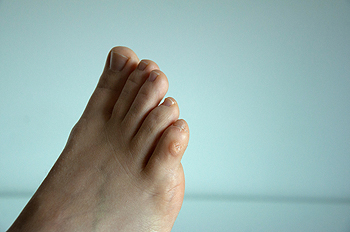 A corn is a hard, yellowed bump or lump just under the skin of the toe or foot. It often develops when the toe rubs against the inside of your shoe, causing pain. People with diabetes or poor circulation may be more apt to develop corns. There are several treatments that can remove or eliminate corns, but if the underlying cause is not corrected, they are likely to recur. Pressure and repetitive friction are the main causes of corns and calluses on the feet. Wearing shoes that are not too tight, or too loose, can help reduce the pressure on the toes. When shoes are too tight or heels too high they can compress the foot; when they are too loose, the foot may slide and rub against them. A seam or stitching on the shoe also can cause repetitive friction. The best way to avoid corns is to wear shoes with room in the toe box, and socks that absorb moisture. Soaking the feet periodically helps soften the corns. For removal of a corn, it is suggested that you make an appointment with a podiatrist for safe treatment and prevention planning.
A corn is a hard, yellowed bump or lump just under the skin of the toe or foot. It often develops when the toe rubs against the inside of your shoe, causing pain. People with diabetes or poor circulation may be more apt to develop corns. There are several treatments that can remove or eliminate corns, but if the underlying cause is not corrected, they are likely to recur. Pressure and repetitive friction are the main causes of corns and calluses on the feet. Wearing shoes that are not too tight, or too loose, can help reduce the pressure on the toes. When shoes are too tight or heels too high they can compress the foot; when they are too loose, the foot may slide and rub against them. A seam or stitching on the shoe also can cause repetitive friction. The best way to avoid corns is to wear shoes with room in the toe box, and socks that absorb moisture. Soaking the feet periodically helps soften the corns. For removal of a corn, it is suggested that you make an appointment with a podiatrist for safe treatment and prevention planning.
Corns can make walking very painful and should be treated immediately. If you have questions regarding your feet and ankles, contact Elliot T. Udell, DPM of New York. Our doctor will treat your foot and ankle needs.
Corns: What Are They? And How Do You Get Rid of Them?
Corns are thickened areas on the skin that can become painful. They are caused by excessive pressure and friction on the skin. Corns press into the deeper layers of the skin and are usually round in shape.
Ways to Prevent Corns
There are many ways to get rid of painful corns such as:
- Wearing properly fitting shoes that have been measured by a professional
- Wearing shoes that are not sharply pointed or have high heels
- Wearing only shoes that offer support
Treating Corns
Although most corns slowly disappear when the friction or pressure stops, this isn’t always the case. Consult with your podiatrist to determine the best treatment option for your case of corns.
If you have any questions please feel free to contact our office located in Hicksville, NY . We offer the newest diagnostic and treatment technologies for all your foot and ankle needs.
More...
Signs and Symptoms of Claw Toes
If trying on shoes isn’t as much fun as it used to be, it may be caused by the development of hammertoes, also known as claw toes. This condition is recognizable by an unsightly bump on the knuckle of the toe, which can rub against the top of your shoe and cause pain. Claw toes can also affect the tip of the toe as it curls under and rubs against the sole of your shoe. They can cause the ball of the foot to become painful, a feeling sometimes described as walking on marbles. Claw toes can be caused by a muscle imbalance, where the long muscles in the leg overpower the smaller foot muscles. Other causes include injury to a tendon, tight calf muscles, and family history. The four lesser toes often develop claw toes, with the second toe the most likely to be affected. Home treatments include wearing shoes with a wider and deeper toe box to relieve rubbing, toe spacers and hammertoe splints, and soft padding to cushion the affected toes. However, if these measures fail to reduce your pain and discomfort, it is suggested that you contact a podiatrist to determine a more advanced course of treatment.
Hammertoe
Hammertoes can be a painful condition to live with. For more information, contact Elliot T. Udell, DPM from New York. Our doctor will answer any of your foot- and ankle-related questions.
Hammertoe is a foot deformity that affects the joints of the second, third, fourth, or fifth toes of your feet. It is a painful foot condition in which these toes curl and arch up, which can often lead to pain when wearing footwear.
Symptoms
- Pain in the affected toes
- Development of corns or calluses due to friction
- Inflammation
- Redness
- Contracture of the toes
Causes
Genetics – People who are genetically predisposed to hammertoe are often more susceptible
Arthritis – Because arthritis affects the joints in your toes, further deformities stemming from arthritis can occur
Trauma – Direct trauma to the toes could potentially lead to hammertoe
Ill-fitting shoes – Undue pressure on the front of the toes from ill-fitting shoes can potentially lead to the development of hammertoe
Treatment
Orthotics – Custom made inserts can be used to help relieve pressure placed on the toes and therefore relieve some of the pain associated with it
Medications – Oral medications such as anti-inflammatories or NSAIDs could be used to treat the pain and inflammation hammertoes causes. Injections of corticosteroids are also sometimes used
Surgery – In more severe cases where the hammertoes have become more rigid, foot surgery is a potential option
If you have any questions please contact our office located in Hicksville, NY . We offer the newest diagnostic and treatment technologies for all your foot and ankle needs.
When the Wound on Your Foot Becomes an Ulcer
Wounds can occur on the feet from an injury, poor circulation, prolonged pressure from improperly fitted shoes, or complications from diseases like diabetes, neuropathy, and vascular disease. Over time, if these wounds do not close and the underlying tissue becomes affected, they are considered ulcers. These types of wounds are potentially dangerous – particularly in people with diabetes. Ulcers can lead to infections in the bone and skin. You can sometimes tell if the wound on your foot has become an ulcer if it is draining, emits a foul odor, or the tissue has become thickened, inflamed, or red. It is important to seek the professional wound care that a podiatrist can provide to help heal the wound and prevent more serious complications from developing. Podiatrists typically begin by cleaning the wound and removing any unhealthy tissue, termed debridement. Antibiotics may be prescribed if an infection is present. They may also suggest certain shoes and orthotics that will keep pressure off the wound and, in severe cases, perform surgery and other methods of wound care.
Wound care is an important part in dealing with diabetes. If you have diabetes and a foot wound or would like more information about wound care for diabetics, consult with Elliot T. Udell, DPM from New York. Our doctor will assess your condition and provide you with quality foot and ankle treatment.
What Is Wound Care?
Wound care is the practice of taking proper care of a wound. This can range from the smallest to the largest of wounds. While everyone can benefit from proper wound care, it is much more important for diabetics. Diabetics often suffer from poor blood circulation which causes wounds to heal much slower than they would in a non-diabetic.
What Is the Importance of Wound Care?
While it may not seem apparent with small ulcers on the foot, for diabetics, any size ulcer can become infected. Diabetics often also suffer from neuropathy, or nerve loss. This means they might not even feel when they have an ulcer on their foot. If the wound becomes severely infected, amputation may be necessary. Therefore, it is of the upmost importance to properly care for any and all foot wounds.
How to Care for Wounds
The best way to care for foot wounds is to prevent them. For diabetics, this means daily inspections of the feet for any signs of abnormalities or ulcers. It is also recommended to see a podiatrist several times a year for a foot inspection. If you do have an ulcer, run the wound under water to clear dirt from the wound; then apply antibiotic ointment to the wound and cover with a bandage. Bandages should be changed daily and keeping pressure off the wound is smart. It is advised to see a podiatrist, who can keep an eye on it.
If you have any questions, please feel free to contact our office located in Hicksville, NY . We offer the newest diagnostic and treatment technologies for all your foot care needs.
Who Is Most at Risk for Age-Related Foot Problems?
Aging is a natural risk factor for many foot problems, including bunions, corns, calluses, hammertoes, ingrown toenails, fungal infections, diabetic foot problems, arthritis, heel pain, tarsal tunnel syndrome, and more. This is because as you age, your feet tend to spread and lose the fatty padding that cushions them. People with certain underlying medical conditions such as diabetes, arthritis, neuropathy, and congenital foot deformities may be more likely to develop foot problems. Specific lifestyle factors like wearing ill-fitting shoes, standing for prolonged periods of time, walking on hard surfaces, and being overweight can all contribute to the risk of foot problems. While medical risk factors are often outside of one’s control, lifestyle factors can usually be modified to prevent potential foot issues. For more information about aging and foot health, it is suggested that you consult with a podiatrist.
If you need your feet checked, contact Elliot T. Udell, DPM of New York. Our doctor will attend to all of your foot and ankle needs and provide you with quality treatment.
Geriatrics and Podiatry
When people age, some common issues that may occur are bone density loss, dry skin, poor circulation, and rough brittle nails. These issues may also affect your foot health if the necessary steps are not taken to alleviate the problems.
It is important to take care of your feet because feet that are injured or diseased can affect your overall health. Having painful feet hinders your ability to do daily activities or may decrease your willingness to do the things that you need to do.
Visiting Your Geriatrician
As we age, health problems become more likely, so it is essential to visit your doctor for check-ups to ensure that you are doing the best you can to take care of your health. It is recommended to check your feet frequently for any possible cuts, bruises, swelling, corns or any other irregularities.
Taking Care of Elderly Feet
Cracked or dry feet can be treated by applying moisturizer often. It is also important not to wear old socks because the older the sock is, the higher the possibility there will be that there is bacteria there. Wear fresh socks and make sure they fit properly.
Proper foot health means that you can have a more active lifestyle and you will not be bogged down by pain. Foot health also leads to good circulation, which is paramount for overall health.
If you have any questions, please feel free to contact our office located in Hicksville, NY . We offer the newest diagnostic tools and technology to treat your foot and ankle needs.
